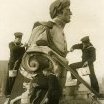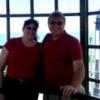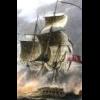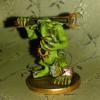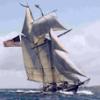MORE HANDBOOKS ARE ON THEIR WAY! We will let you know when they get here.
×
-
Posts
528 -
Joined
-
Last visited
Reputation Activity
-
 harvey1847 reacted to EdT in Young America 1853 by EdT - FINISHED - extreme clipper
harvey1847 reacted to EdT in Young America 1853 by EdT - FINISHED - extreme clipper
Young America - extreme clipper 1853
Part 42 – Internal Hull Work
With the hull framing finished it was time to step back and consider the right construction sequence going forward. Rather than go to work fairing and sanding the outer hull as I has anticipated, I decided to focus next on some of the basic internal structural elements. Installing some key internal longitudinal members will add a lot of strength to the frames, in particular the connections of the full square frames at the keel. These joints are rather weak and may not stand up well to outside sanding. In practice this joint was strengthened by use of a very heavy garboard strake (the plank next to the keel) that was bolted up through the floors and lower futtocks. This 9” thick block was in turn edge bolted into the keel. The garboard was a much more important structural member in these ships than the familiar 18C RN subjects.
The first step was to fair out the inboard sides of the frames. The full square frames had been carefully checked for fairness before locking them forever into place when the keelson was installed. The careful pre-beveling of the half and cant frames and the use of the topside ribband to set these resulted in a pretty fair surface. A few had to be removed and reset.
The first picture shows the first sanding/fairing step using 120-grit paper and a “soft-sander” foam pad.
Once all the surfaces were faired out with the 120-grit paper, 220-grit was used to start smoothing the surfaces. In the next picture a round piece of a soft-sander pad is stuck to a vibrating sander and it turn has some 220-grit paper attached to that – all with two-faced carpet tape, A few different pad shapes were used.
This was followed by 320-grit, using the same device. There was also a lot of old-fashioned handwork with all this sanding.
In the next picture the wood is being given a final polish with #0000 steel wool.
I don’t like using steel wool very much – it leaves a lot of steel fibers lying around and this also adheres to steel tools. But after years of searching, I have found nothing that polishes bare hardwood like steel wool, so I am using it here - #1, then #0, then #0000. All the tools are cleared away before doing this and the shop-vac comes out frequently.
With the inside of the hull given its final polishing, the lines of the deck clamps were scored on the frames as shown in the next picture.
A thick pine batten was first clamped to the frames as shown. The heights of the clamps were taken off the inboard arrangement drawing with the calipers shown below. These will be familiar to those who followed Naiad.
To allow the measurements to be transferred to the inside of the hull a thin strip was taped on top of the original arm to fit through the frame gaps.
The next picture shows the batten set at the height of the middle deck. The lower deck clamps on both sides have been marked. The upper (or main) deck clamps will be just below and essentially parallel to the temporary ribbands clamped to the outside of the frames. When those clamps are installed, the outside ribbands can be removed
Removing the temporary ribbands and strengthening the framing with internal members will allow the outside of the hull to be completely faired and finish sanded from the keel up to the top rail.
In the next part members of the “bilge ceiling” will be installed below the line of the lower deck clamp.
Ed
-
 harvey1847 reacted to Mirabell61 in PAMIR 1905 by Mirabell61 - FINISHED - 1:96 - four-masted barque as she appeared since 1951/1952
harvey1847 reacted to Mirabell61 in PAMIR 1905 by Mirabell61 - FINISHED - 1:96 - four-masted barque as she appeared since 1951/1952
Build log part 2
working out and drawing the individual Frames in order to suit this build
each Frame gets its own 1:1 drawing on paper
rough cut out of the paper and fix on 4 or 5 mm thick plywood
an obligatory base plate is set up to Keep all in alignment and to get (and keep) the keelline straight during the further build
cut out Frames in preliminary set up, to see if all Frames are straking well
cross check, yes it Looks like Pamirs lines of the early hull
the model is being built keelside up, the Frames complete cut out, and the notches for the stringers done
all looks well so far
due to the fix on the baseplate all frames bear Surplus height, to bring (only interim, will be cut to suit later on)to the same level
like a strong man Needs a strong Backbone, I have arranged for a "spine" 20 x 20 mm square beam to reinforce the hull for taking on the induced tensile stresses of all the stay and shrouds spanning, working on the hull later on. I never regretted to do this...
well under way now, the stringers as well as the ships lines clearly to be seen now
Build log part 3 to follow...
Nils
-
 harvey1847 reacted to Mirabell61 in PAMIR 1905 by Mirabell61 - FINISHED - 1:96 - four-masted barque as she appeared since 1951/1952
harvey1847 reacted to Mirabell61 in PAMIR 1905 by Mirabell61 - FINISHED - 1:96 - four-masted barque as she appeared since 1951/1952
Sailing ship, fourmast-barque PAMIR in scale 1:96
Introduction to this build log, by Nils Langemann
For modeling one of the famous “Flying P-Liners” of the last century, my choice fell on the PAMIR because that ship probably would be supported with most available information one can get in the appropriate media. Much has been written about the various owners, the crews,the routes, etc, and all this illustrated on the web, in literature, reports, photos, paintings and models in all qualities and scales, without here considering many various very good moulded plastic kit models.
Most of all was reported about the tragic loss in Sept. 1957 when the hurricane “Carrie” called for its tribute. 80 of 86 crew members, mostly young men, lost their lives after their ship had finally capsized and sank within minutes, southwest of the Azores islands of the Atlantic, this causing the to date largest and most intensive post WW2 international coordinated search and rescue operation in the civil marine history. Trust the older MSW members still remember the news-clips and film reports of the 6 wounded roughbeaten survivers and their pictures as they told their story, after being rescued from their broken lifeboat wreck-hulks and after several days ongoing struggle for life.
Most of the available plans for modeling the 1905 at Blohm an Voss built and launched Pamir, as well as many models exhibited in worldwide museums show the Pamir in all versions as she looked like before 1951, several changes in paint and slight modifications, acc. To the owner and nations and to suit its owners cooperate identity appeal had been made.
I was looking for an authentic plan of the version after the major changes at the Howaltswerke- Deutsche Werft, Kiel in northern Germany in years 1951 /1952, and after which the ship was under the Hamburg based subsiduary of shipping company Zerssen & Co, whereby the homeport was Lübeck. A couple of german shipping companies founded an association that together with Zerssen as the ship relevant managing part, enabled the training of young civil nautical and sailor-handcraft in a win-win situation for both trainees and shipping companies. The old well known Laeisz colour of the P-liners had been chosen again, and the ship, still being a trade cargo vessel under sails routed to South American ports around the Cape Hoorn performed many trips. At the same time the Passat, (today still afloat as Museumship in Travemünde near Lübeck, Germany) was also changed and appointed for same further activities.
The plan of performed changes was available and purchased from the Howaltswerke shipyard, and for the Frame/ Bulkhead plan I found authentic original Blohm and Voss drawings in a book of Hamburgs sailing ships 1795-1945, Author Jürgen Meyer. This model took me two years to build, and it is comprising about 1950 manhours modeling. More about design, preparing for the build, construction as well as information on the model will be given along with the Build log sequences as they are posted….
The already completed model 1:96, length 119,5 cm, can be viewed in my album, topic “Gallery of completed scratch built models”, Pamir 4-mast barque version as 1957
For all that also love these wonderfull squarerigger tallships, enjyoy and stay tuned to the build log….
Nils
I ca`nt realy say today how many log-parts in total it will take, it depends on how much interest the fellow MSW members shall have as to the extension of the individual build sequences. If the interest should be like it was with the Heinrich Kayser build log, it probably would be the "whole program"
Nils
here we go....
Build log part 1
I am lucky to have my own hobby-room office
These are pics of the proud and sturdy built Pamir which hundreds of nautic Trainees may have in good rememberance
in Sept 1957 came the shocking flash-News of the foundering of the ship, and also over the to date greatest post WW2 search and rescue Operation in civil marine history.
This frightning realistic pencil drawing by Artist Franz Richter Johnsen I feel is so emotional touching. It is showing the Pamir in its agony just before capsizing (masts down) and thereafter to sink within minutes. That was an indication that the hull must have been broken, otherwise it would certainly have stayed afloat some hours, even in that illfated position, and the S&R Groups could have made her out better
I was often asked what plan-drawings I had for doing this project, and would like to bring attention to two very informative books... (I am in no way associated with the authors or its Distribution)
There is first : Hamburgs Segelschiffe 1795-1945, author, Jürgen Meyer, can be found preferably at book antiquariates
it contains amoungst many other beautiful Tallships, copies of original Blohm + Voss Pamir plans.
The Basic Frame / bulkheadplan was used for my model
There is second : a relatively new publication, Die Letzten Flying P-liner, by Andreas Gondesen, who I consider as one of the best knowledgeable authors of the famous P-Liners, their History, as well as pointing out the differences between Pamirs several "Sister" ships, hardly known to the public.
The great benefit of this book is the wonderful accurate detailed large plan in poster Formate of the Pamir in scale 1:100, that comes along included with the publication. (it is representing the Version before 1951 though), but never the less a must for Pamir modelers
outcut from Gondesens Pamir plan
many handscetches had been made by myself, here only some examples
for those of you who know how good the extruded quality and precision of the Heller plastic Pamir kit and its moulds are in scale 1:150, I took the measurements for the various deckhousings from a wrecked plastic torso I found in a bin, and magnified these ratings to scale 1:96
Whoever does not know the Heller kit, please be advised, it is representing the precise Pamir Version of 1951 /1952 in top quality, but on a high skill Level
Together with a plan comprising all the changes to the Pamir from Howaltswerke Deutsche Werft in Kiel, I was ready to get my project under steam at last......
Build log part 2 to follow...
-
 harvey1847 got a reaction from Jorge Diaz O in HMS Triton 1773. POF. 1:48. Daniel
harvey1847 got a reaction from Jorge Diaz O in HMS Triton 1773. POF. 1:48. Daniel
Hola Amigos! (put it mexican accent like in the movies)
Well... It took me almost one month.
The worst part has been to remove all the patterns and PVA glue from the frames. I did it using just water and a brush wetting the frames (three or four at a time. Then with an x-acto blade I scrapped the glue or the pattern working extremely carefully trying not harm the wood...
here are some pics. Not in order.
I have printed out the stern timbers and the lights. That´s where I am going to move on in order to make the main wales. I am kind of following Wang´s log.
Happy Sunday!
daniel.
-
 harvey1847 got a reaction from jaerschen in HMS Triton 1773. POF. 1:48. Daniel
harvey1847 got a reaction from jaerschen in HMS Triton 1773. POF. 1:48. Daniel
Hola Amigos! (put it mexican accent like in the movies)
Well... It took me almost one month.
The worst part has been to remove all the patterns and PVA glue from the frames. I did it using just water and a brush wetting the frames (three or four at a time. Then with an x-acto blade I scrapped the glue or the pattern working extremely carefully trying not harm the wood...
here are some pics. Not in order.
I have printed out the stern timbers and the lights. That´s where I am going to move on in order to make the main wales. I am kind of following Wang´s log.
Happy Sunday!
daniel.
-
 harvey1847 got a reaction from kruginmi in HMS Druid by Krug - FINISHED - 1:48 - Hahn
harvey1847 got a reaction from kruginmi in HMS Druid by Krug - FINISHED - 1:48 - Hahn
Hi Mark!
I thought was boxwood like Bugra and I guess others. Thanks for the ladder jig practicum! Copy and saved on my "research folder"...
Beautiful work!
Daniel.
-
 harvey1847 reacted to kruginmi in HMS Druid by Krug - FINISHED - 1:48 - Hahn
harvey1847 reacted to kruginmi in HMS Druid by Krug - FINISHED - 1:48 - Hahn
Success breeds progress. Tonight was to climb the mountain.that I had thought about for a long time - the pumps.
I had lathed out rods to represent the pumps a LONG time ago (in a galaxy / home far - far away). Ever since then I had known that I wanted to improve their look above the deck where they were most visible. That decision had churned in my brain ever since, growing larger and larger in mythical proportions of complexity. Today was the day, they had to be done.
The following shows a before and after shot (hopefully you can tell the bottom pump is the before):
As is usually the case, the reality wasn't that bad at all. After marking where the pumps came through the deck, that line was scribed with a knife and the rod paired down. I used a draftsman guide of six sided shapes to find the appropriate size that I wanted. Wood was cut to these dimensions and I eyeballed the necessary bevel at the edges. These were then glued together and onto the rod.
I used piece of boxwood for a cap. The actual handle will be generated later.
Tomorrow the gun deck planking begins. mark
-
 harvey1847 reacted to kruginmi in HMS Druid by Krug - FINISHED - 1:48 - Hahn
harvey1847 reacted to kruginmi in HMS Druid by Krug - FINISHED - 1:48 - Hahn
Making some headway, the last connection to the berth deck was the ladder. I decided a jig was necessary and I came up with below:
The length of the gaps allowed some tension to be available to hold the treads while the sides are applied. I first measured the tread depth from the plan unfortunately from the stairs from the gun / main deck to the quarter deck. After putting the stairs in place it was pretty obvious this didn't leave a lot of room for sailors to make it through the coaming!
Upon further investigation I found a view off to the side that showed a much skinnier tread. The jig now paid off since it was just five minutes before I had a replacement made. The result was much more viable:
With the windlass plate off you can see the two sets of stairs from both decks. This will definitely work.
As i complete the deck requirements from bow to stern I will very soon be laying the deck planks.
Mark
-
 harvey1847 reacted to kruginmi in HMS Druid by Krug - FINISHED - 1:48 - Hahn
harvey1847 reacted to kruginmi in HMS Druid by Krug - FINISHED - 1:48 - Hahn
As I move to the gun deck (which is actually visible as the top main deck) everything added really has a big impact. As I work to get the hatch coamings affixed I got one last look at a component that I was particularly proud of. Once it was affixed most of the beauty was hidden but at least I have photographic evidence!
The following is the installed view with and without the associated quarterdeck roof.
To permanently affix the deck beams I needed to add the waterways. Given the flow of the hull, the waterway from the stern to close to the bow was affixed in one straight piece, slightly bent and glued into place. For the profile, the same scraper was used as the berth deck. For the bow, I used my favorite technique of using post-it notes to get the rough shape, followed by a piece of paper to refine, finally using the correct wood.
When the port piece was cut out I was happy to find that by flipping it over it fit just fine in the starboard side. I love it when these things like that happen.
Mark
Now on actually laying planks (as soon as the stairway coaming is put in).
-
 harvey1847 reacted to kellrandy in Triton (1:48) by kellrandy (Randall)
harvey1847 reacted to kellrandy in Triton (1:48) by kellrandy (Randall)
Hi all, back with a little bit more progress... The first set is the mounting to the board to get ready for framing. Since the build board is a pretty good size, I acquired some table legs with locking wheels so I could rotate it around to get to all aspects from any angle. Also, the mounting is set up the same way with as little in the way as possible without compromising security and support for the keel, stem, and stern. The second is the second go with the transoms, they're almost ready to glue in place, plus I have to remake filling #3, that's why it's not in the photos. I broke it in half while I was tapering it, oops. I learned quick not to cut the notch before I shape them, lol.
Build board mounting...
The transoms, test fitting...
Have a good week everyone!
Randall
-
 harvey1847 got a reaction from KevinR in DKM Scharnhorst by Paul Salomone - 1:72nd Scale - German WW2 Battlecruiser
harvey1847 got a reaction from KevinR in DKM Scharnhorst by Paul Salomone - 1:72nd Scale - German WW2 Battlecruiser
Beautiful kitchen! what a nice job Paul.
I have similar expirience since I made my own house from an old stone shed of the nineteenth century... It only took seven years to acomplished the whole thing. This summer I have finished all the frames (22) and the doors (12). That´s why I could not be modelling a lot. As you, there´s lots of things to do but now is habible and seven years ago it was nothing but a ruin.
the ruin, looks in good shape but believe me it was not.
demolishing the roof, all the timber had woodworms, I could use none of them.
New pillars and beams, really fun stuff with the chainsaw and 200mm nails. At this time I joined the old MSW 1.0 getting traped with EdT´s Naiad... and then I joined the Triton project
And the final result, still lots of things to do.
Best wishes Paul! There is something priceless when you do the things by yourself.
Daniel.
-
 harvey1847 reacted to Remcohe in HMS Kingfisher 1770 by Remcohe - 1/48 - English 14-Gun Sloop - POF
harvey1847 reacted to Remcohe in HMS Kingfisher 1770 by Remcohe - 1/48 - English 14-Gun Sloop - POF
No can do John , but I can tell you it was a nice little project I can recommend to every one. Those shallow drawers are just great. Next to this I use Ikea's little boxes to store other tools and supply's unfortunately they don't sell this type any more, a real shame. I'm still looking for a better way to organize my sanding paper, keeping them in a big stack is not working...
So back to making bulkheads, I use wooden peg's under the stanchions to temporary fit and adjust until I'm getting a fit I like.
The cook's working space was not very big. Behind the riding bitt's there is another bulkhead drawn on my plan I thin I'll make a nice cupboard for the cook to store his pot's, pan's and other tools.
-
 harvey1847 reacted to Matrim in Triton (1:48) by kellrandy (Randall)
harvey1847 reacted to Matrim in Triton (1:48) by kellrandy (Randall)
Makes sense and dont we all hate fairing...
-
 harvey1847 got a reaction from robbl in HMS Triton 1773. POF. 1:48. Daniel
harvey1847 got a reaction from robbl in HMS Triton 1773. POF. 1:48. Daniel
Hola Amigos! (put it mexican accent like in the movies)
Well... It took me almost one month.
The worst part has been to remove all the patterns and PVA glue from the frames. I did it using just water and a brush wetting the frames (three or four at a time. Then with an x-acto blade I scrapped the glue or the pattern working extremely carefully trying not harm the wood...
here are some pics. Not in order.
I have printed out the stern timbers and the lights. That´s where I am going to move on in order to make the main wales. I am kind of following Wang´s log.
Happy Sunday!
daniel.
-
 harvey1847 got a reaction from Small Stuff in HMS Triton 1773. POF. 1:48. Daniel
harvey1847 got a reaction from Small Stuff in HMS Triton 1773. POF. 1:48. Daniel
Hola Amigos! (put it mexican accent like in the movies)
Well... It took me almost one month.
The worst part has been to remove all the patterns and PVA glue from the frames. I did it using just water and a brush wetting the frames (three or four at a time. Then with an x-acto blade I scrapped the glue or the pattern working extremely carefully trying not harm the wood...
here are some pics. Not in order.
I have printed out the stern timbers and the lights. That´s where I am going to move on in order to make the main wales. I am kind of following Wang´s log.
Happy Sunday!
daniel.
-
 harvey1847 reacted to Jeronimo in LE BONHOMME RICHARD by Jeronimo - FINISHED
harvey1847 reacted to Jeronimo in LE BONHOMME RICHARD by Jeronimo - FINISHED
Hello,
capstan prepared for installation on the gun deck.
Karl
T e i l 42
-
 harvey1847 got a reaction from popeye the sailor in DKM Scharnhorst by Paul Salomone - 1:72nd Scale - German WW2 Battlecruiser
harvey1847 got a reaction from popeye the sailor in DKM Scharnhorst by Paul Salomone - 1:72nd Scale - German WW2 Battlecruiser
Happy birthday Paul!
No home work and no modelling today!
Daniel.
-
 harvey1847 reacted to robbl in HMS Blanche 1800 by robbl - 1/48 - POF - was HMS Euryalus 1803
harvey1847 reacted to robbl in HMS Blanche 1800 by robbl - 1/48 - POF - was HMS Euryalus 1803
Hi all
A little bit of progress internally. First, I added t-track and bolts to the building board so my gantry can be used for height measurment and clamping. Then, a new assistant supervisor was appointed.....
Retired Admiral the Lord Bob brings experience to the task.
Then, to learn about making decks and platforms, I decided to start with the aft magazine and platform, as it looked a lot simpler than the fore platorm. First I used the bulkheads I had made from Matai in the last progress post to construct the walls of the aft magazine.
And I also cut the aft platform beams from Totara, and checked their positioning for height along with the magazine.
I started with the idea of milling the mortices, but that took longer than cutting them with a scalpel and small chisels. This effort highlighted two things - I need smaller chisels and I need to cut away from the hand ... blood is on the underside of the beams.
At this stage I realised my potential for getting all the angles and measurements wrong while working inside the hull was immense, so made slots in a piece of offcut wood to allow me to construct the platform off ship.
This allowed me to line up the timbers and their mortices and hold everything nicely in place while I worked, so I ended up with this....
Which when placed back in the hull with the magazine looks like this ....
So I still have to do the knees, and until I do, the platform will not be fixed inside the hull. You might notice, in the close up of the top down image attachment below, the magazine has its floor planked (Rimu), next for it will be the internal bulkheads, lightroom fittings and doors. The "jig" for the platform worked so well, I plan on continuing that method for the orlop deck and fore platform, however I want to finish this aft area first.
oh, almost forgot, another "take-away lesson" from this was to avoid the use of blu-tack to test fit the beams in place ... it was difficult to get off afterwards.
Cheers
Rob
-
 harvey1847 reacted to Piet in Hr. Ms. O 19 1938 by Piet - FINISHED - scale 1:50 - submarine of the Royal Navy Netherlands in service 1939 - 1945
harvey1847 reacted to Piet in Hr. Ms. O 19 1938 by Piet - FINISHED - scale 1:50 - submarine of the Royal Navy Netherlands in service 1939 - 1945
Hey Boris - - - see what I have done this afternoon - - -
This shows the conduit with the box temporarily put into place for a fit look. I made one for each side
After some adjustments they are glued in place using ca and they need some paint. I still need to add the black squares yet.
This shows a small supply of 1 X 1 mm slats for the deck. I started with the aft deck and glued only a few. More to come Sunday, I think. If the weather is good I need to do some yard chores
Cheers,
-
 harvey1847 reacted to Gaetan Bordeleau in LE BONHOMME RICHARD by Jeronimo - FINISHED
harvey1847 reacted to Gaetan Bordeleau in LE BONHOMME RICHARD by Jeronimo - FINISHED
http://warfrog.blogspot.ca/2011/10/white-metal-casting-tutorial.html
complete kit $230 US
-
 harvey1847 reacted to EdT in Young America 1853 by EdT - FINISHED - extreme clipper
harvey1847 reacted to EdT in Young America 1853 by EdT - FINISHED - extreme clipper
Thank you all again for these comments and for all the "likes."
Daniel, that is a very nice diagram. It is similar in some structural aspects to YA, but the hull shape is much fuller.
Druxey, the progress was faster than I expected. Perhaps everyone might be interested in some comparisons with Naiad:
This point was reached on Young America in 5 months - on Naiad 11 months.
Naiad had 61.5 frame pairs (41.5 full and 20 cants) consisting of about 960 frame pieces including chocks. YA has 80 frame pairs (50 full, 19 half and 11 cants) - also about 960 pieces. In spite of the scale difference (Naiad 1:60, YA 1:72), the frames are very similar in size.
I attribute the more rapid progress on YA to the following:
Although the number of pieces in total are about the same,YA frames are simpler - no chocks, all are sistered with no spaces - no free standing frames. I cut Naiad's gunports after all this work, so it was not a factor.
The frame assembly process used on YA was very much faster. Using the pin-indexed process, assembly time was about one-quarter that on Naiad - even with the full bevelling on YA's frames before erection. Naiad's frames were only roughly bevelled.
Frame erection was also much faster. With the paired frames there were fewer individual pieces to erect. Cant and half frame setting was very fast using the planksheer ribband method - no more than five to 10 minutes per side for a pair.
YA probably also benefited from my ascension on the framing learning curve since Naiad. Although I was still experimenting with different processes on YA, I am sure that had an effect.
Again, thank you all for your comments and interest. Hopefully the rest of the project will go as well.
Ed
-
 harvey1847 got a reaction from Elmer Cornish in Young America 1853 by EdT - FINISHED - extreme clipper
harvey1847 got a reaction from Elmer Cornish in Young America 1853 by EdT - FINISHED - extreme clipper
Congratulations Ed!!
You that write everything... How long took you to complete the hull since you lay down the keel on the dockyard? Five months?
Can´t wait to see all the interior work..., a lot of difference between from a Man O War ship I guess.
Congratulations again!
Daniel.
-
 harvey1847 reacted to Rustyj in Bomb Vessel Granado by Rustyj - FINISHED - 1:24 - cross-section
harvey1847 reacted to Rustyj in Bomb Vessel Granado by Rustyj - FINISHED - 1:24 - cross-section
Thank you all for stopping by for a look and all the likes!
Grant, "Creative Accounting" here usually comes with free room and board for 5 to 10 years.
Not to worry the lathe will be here eventually.
I have received a notification from the author of the plans that there was a slight error. The
cannon were drawn at the wrong size. The new sheet of plans was received and you can see
the difference below. Good news is that I haven't made the barrels so nothing lost there and
I will get some more practice making the carriages today.
Also I have made the ladder but it is just set in place for now. I want to be able to remove it
for when I rig the cannon.
-
 harvey1847 reacted to EdT in Young America 1853 by EdT - FINISHED - extreme clipper
harvey1847 reacted to EdT in Young America 1853 by EdT - FINISHED - extreme clipper
Young America - extreme clipper 1853
Part 41 – Aft Half Frames 2
Now for the final hull frames.
The first picture shows two half frames being glued to opposite sides of the keelson using a different method of clamping than that used for the previous frames.
As the framing moves forward the frames become more full at the base. This makes the use of screw clamps increasingly awkward. For the remaining frames the feet were held in place for the toptimber pinning and then gluing using the method shown. Wood strips are pushed to the frame and held in place by the T-track clamps. This proved much easier and, as is shown in the picture, frames on either side could be installed concurrently.
The next picture shows a closer view and also a 1:72 figure – by special request.
In the next picture a frame is being pinned to the ribband at the top while held against the keelson at the base.
After pinning, the clamp is pulled back, glue is applied to the the joint and the clamp returned until the glue dries.
The pin-indexing method of assembling frames requires that all but the toptimbers are of the same siding, in this case 12”. The upper futtocks then need to be reduced in thickness after assembly, bevelling and removal of the patterns. In the next picture this is being done with a flat file.
These pieces are awkward to secure in a vise, so for this work they were pinned to a piece of Homasote board through the bolt holes.
In the next picture, the fairness of the external hull is being checked before installing the last half frame on the side.
This is also being done on the inside in the next picture.
The frames were pre-beveled to within to within roughly 1/64” of final breadth – to the outer side of the pattern lines inboard and outboard on each face. Where there are gaps of more than about 1/64” when checked as above, the offending frame was removed and reset. There were only a few of these and resetting their height brought them within range. Final sanding will finish the job.
In the next picture the last frame is being pinned to the ribband by bending over the end of the pin. The foot of the frame foot was then glued to the keelson.
Installation of this last frame was a big milestone. The last two pictures show the full hull after completing the framing.
There is no doubt that some of the toptimbers will need to be replaced later to precisely fair the upper rails. Hopefully the number will be few, but these small pieces are most subject to error when assembling the frames. They are indexed in assembly by only two pins and the pins are close together. One has already been removed below.
The hull is now ready for final fairing.
Ed
-
 harvey1847 reacted to Remcohe in HMS Kingfisher 1770 by Remcohe - 1/48 - English 14-Gun Sloop - POF
harvey1847 reacted to Remcohe in HMS Kingfisher 1770 by Remcohe - 1/48 - English 14-Gun Sloop - POF
Thanks all for your kind words. You are welcome to come over and cook a meal on the stove.
I've been busy with a side project, inspired by Geatans tool drawers I decided to rebuild one of my tool cabinets and upgraded a 5 drawer Ikea cabinet to a 9 drawer tool cabinet.
After that is was time to add more planking (more than I had intended before I started on the hearth. And making bulkheads. Here the first is ready with added small strips to act as rebates
The bulkheads are made from 20 cm strips, glued and then cut to size. I think this works better than my previous approach by gluing each strip in situ. Along the way I needed to make the upper deck hook to test fit the bulkhead.
Remco



